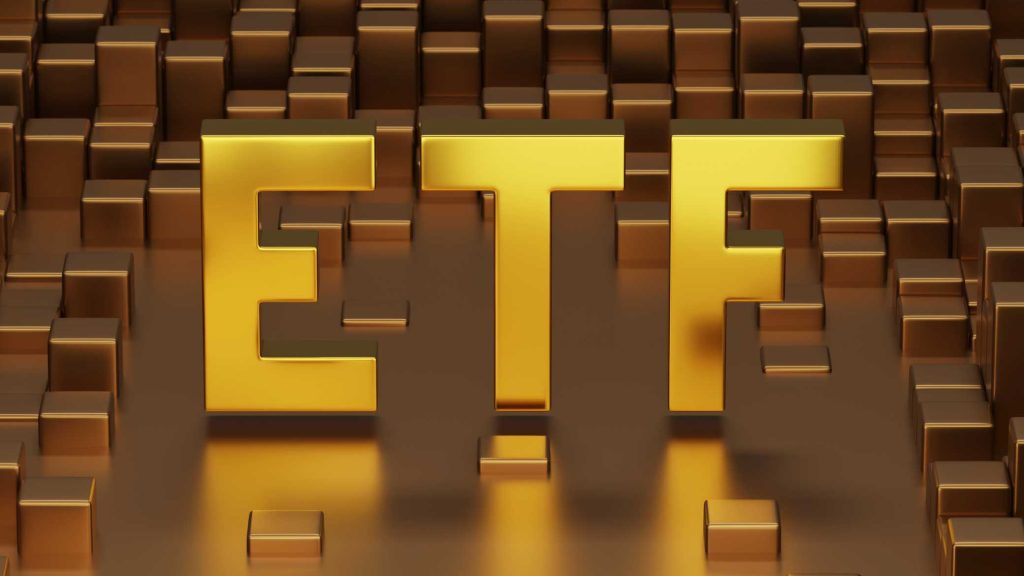Top 5 Gold ETFs in 2025 : Comprehensive Guide
Top 5 Gold ETFs in 2025 : In 2025, gold remains one of the most trusted and time-tested investment assets for Indian investors. Whether you are a first-time investor or a seasoned portfolio builder, allocating a part of your wealth to gold provides an essential hedge against inflation, currency depreciation, and market uncertainty. The modern way to invest in gold is not by purchasing physical bars or jewelry but through digital instruments such as Gold Exchange-Traded Funds (ETFs) and Gold Fund of Funds (FoFs).
Table of Contents
These instruments combine the safety of gold with the convenience of mutual funds and the transparency of stock market trading. In this comprehensive guide, we will explore the Top 5 Gold ETFs/Funds in India for 2025—their structure, features, benefits, risks, and why they may deserve a place in your investment portfolio.
Understanding Gold ETFs and Gold Funds
Before diving into the list, it’s essential to understand what Gold ETFs and Gold Funds actually are. A Gold ETF (Exchange-Traded Fund) is a mutual fund that tracks the domestic price of physical gold. Each unit of a gold ETF typically represents 0.01 grams or 1 gram of gold, and the fund’s performance mirrors the price movement of gold in the market. Gold ETFs are traded on stock exchanges like NSE or BSE, and investors can buy or sell them just like stocks during market hours.
Also Read : How to Manage Personal Loan EMI Without Stress – Comprehensive Guide 2025
On the other hand, Gold Fund of Funds (FoFs) are mutual fund schemes that invest in underlying Gold ETFs. These funds allow investors to gain exposure to gold without needing a demat account. Investors can use SIP (Systematic Investment Plan) or lump-sum options to buy units, and transactions are executed at the day’s NAV (Net Asset Value). Essentially, Gold FoFs are a convenient way for retail investors to participate in gold’s performance without direct stock market operations.
Why Invest in Gold in 2025?

The year 2025 continues to be shaped by economic uncertainty, geopolitical tensions, and inflationary pressures across major economies. Gold, known as the “safe haven asset,” performs well during such times. Several reasons make gold a must-have in your portfolio this year:
- Hedge Against Inflation: Gold maintains purchasing power when fiat currency weakens. With rising consumer prices globally, gold remains an effective inflation shield.
- Diversification: Gold often moves inversely to equities, reducing overall portfolio risk and volatility.
- Liquidity: Gold ETFs and FoFs can be easily bought and sold without dealing with physical storage or purity concerns.
- Global Economic Uncertainty: Gold tends to rise when global markets experience turmoil, offering stability in uncertain times.
- Ease of Investing: With gold ETFs and FoFs, investors can start with as little as ₹100 and gain exposure to global gold prices digitally.
Taxation of Gold ETFs and Gold FoFs in 2025
After the taxation reforms introduced by the Indian government, Gold ETFs and FoFs are treated as non-equity mutual funds. As of 2025, if the investment is held for less than 36 months, the gains are taxed as Short-Term Capital Gains (STCG) at the investor’s income tax slab rate. For holdings longer than 36 months, it is treated as Long-Term Capital Gains (LTCG) and taxed at 20% with indexation benefits, allowing investors to adjust the purchase price for inflation. Investors should always verify the latest tax rules applicable in the financial year of their investment.
Top 5 Gold ETFs/Funds in India 2025
Now let’s explore the top-performing and most reliable Gold ETFs and FoFs available in India for 2025. This list is based on performance consistency, fund management quality, AUM size, expense ratio, liquidity, and investor trust.
1. Nippon India ETF Gold BeES
Overview:
Nippon India ETF Gold BeES is one of India’s oldest and most trusted gold ETFs. It directly tracks the domestic price of gold and holds physical gold of 99.5% purity in secured vaults. This ETF is ideal for investors who have a demat account and prefer direct exchange-based trading.
Key Features:
- Structure: Exchange-Traded Fund
- Investment Objective: To provide returns closely corresponding to gold price movements.
- Minimum Investment: 1 unit (approximately equal to 1 gram of gold)
- Expense Ratio: Approximately 0.80% annually
- Liquidity: Highly liquid, actively traded on NSE and BSE
- Tracking Error: Low due to efficient management
Advantages:
- Transparent pricing and instant liquidity
- Ideal for traders and investors comfortable with stock exchanges
- Cost-efficient compared to physical gold investment
Best For:
Investors who want to hold gold as a part of a diversified digital portfolio with low expense ratios and easy tradability.
2. UTI Gold ETF Fund of Fund – Regular Growth
Overview:
UTI Gold ETF Fund of Fund invests in the UTI Gold ETF, offering investors an easy route to invest in gold without the need for a demat account. The fund provides the convenience of SIP investments while maintaining a strong track record of performance.
Key Features:
- Structure: Fund of Fund investing in UTI Gold ETF
- Investment Objective: To generate returns in line with gold price movements
- Expense Ratio: Around 0.56% for regular plan (may vary)
- Minimum Investment: ₹500 (lump sum or SIP)
- Exit Load: 1% if redeemed within 15 days
Advantages:
- No need for a demat account
- Easy SIP/STP options for long-term investors
- Managed by UTI Mutual Fund, one of India’s most reputable AMCs
Best For:
Investors looking for a convenient way to invest in gold regularly via SIPs without dealing with trading or brokerage complexities.
3. SBI Gold Fund – Regular Growth

Overview:
SBI Gold Fund is one of the largest gold FoFs in India by AUM. It invests primarily in SBI Gold ETF, thereby reflecting the price performance of physical gold. The fund’s scale, low expense ratio, and SIP flexibility make it a top choice for long-term investors.
Key Features:
- Structure: Fund of Fund investing in SBI Gold ETF
- Expense Ratio: Around 0.35% for regular plan (excluding ETF costs)
- AUM: Over ₹5,000 crore (approximate as of 2025)
- Minimum Investment: ₹500
- Exit Load: 1% if redeemed before 15 days
Advantages:
- Backed by SBI Mutual Fund’s vast experience and credibility
- Large AUM ensures efficient management and liquidity
- Offers SIP and STP facilities for disciplined investing
Best For:
Conservative investors seeking a stable and trusted platform to invest in gold through India’s leading public sector AMC.
4. Axis Gold Fund – Regular Growth
Overview:
Axis Gold Fund is another well-managed gold FoF that allows investors to invest indirectly in Axis Gold ETF. It is suitable for individuals who want to start small and build gold exposure gradually through SIPs.
Key Features:
- Structure: Fund of Fund investing in Axis Gold ETF
- Expense Ratio: Approximately 0.50%
- Minimum Investment: ₹100 for SIP (one of the lowest entry thresholds)
- Exit Load: 1% if redeemed within 15 days
Advantages:
- Extremely low entry point makes it accessible to all investors
- Regular SIP mode helps build gold holdings over time
- Backed by Axis AMC’s disciplined and transparent management approach
Best For:
First-time investors who wish to build gold exposure gradually with small SIP amounts and prefer a hassle-free mutual fund route.
5. Quantum Gold Savings Fund – Regular Growth
Overview:
Quantum Gold Savings Fund invests primarily in Quantum Gold ETF, offering investors a convenient, demat-free way to gain exposure to gold prices. Quantum AMC is known for its low-cost, investor-first approach and transparency in fund management.
Key Features:
- Structure: Fund of Fund
- Expense Ratio: Around 0.60%
- Minimum Investment: ₹500
- Exit Load: 1% if redeemed within 15 days
Advantages:
- Transparent investment process
- Regular disclosure of holdings and tracking performance
- Ideal for SIP-based investors looking for simplicity and long-term compounding through gold exposure
Best For:
Investors seeking a reliable and straightforward option from a fund house known for low-cost operations and investor transparency.
Comparing the Top 5 Gold ETFs/Funds in 2025
| Fund Name | Type | Expense Ratio | Minimum Investment | Exit Load | Demat Required | Ideal For |
|---|---|---|---|---|---|---|
| Nippon India ETF Gold BeES | ETF | ~0.80% | 1 unit | No | Yes | Traders & investors with Demat |
| UTI Gold ETF FOF | FoF | ~0.56% | ₹500 | 1% (15 days) | No | SIP investors |
| SBI Gold Fund | FoF | ~0.35% | ₹500 | 1% (15 days) | No | Long-term SIP investors |
| Axis Gold Fund | FoF | ~0.50% | ₹100 | 1% (15 days) | No | First-time investors |
| Quantum Gold Savings Fund | FoF | ~0.60% | ₹500 | 1% (15 days) | No | Transparent low-cost investing |
How to Choose the Best Gold ETF or Fund
When selecting a gold ETF or FoF, consider the following parameters:
- Investment Mode: If you already have a demat account, a Gold ETF like Nippon Gold BeES is efficient. Otherwise, choose a FoF.
- Cost Efficiency: Lower expense ratios translate to better long-term performance.
- Liquidity and AUM: Funds with higher AUM are generally more stable and liquid.
- Investment Horizon: Gold is best held for 3–5 years as a hedge, not for short-term speculation.
- Ease of Investment: FoFs allow SIPs, which help automate discipline in wealth building.
- Tax Implications: Check if your investment horizon aligns with long-term capital gains benefits.
The Role of Gold in Your Portfolio
Gold should ideally constitute 10–15% of your total portfolio, depending on your risk appetite and market outlook. It acts as a stabilizer when equities face volatility and provides protection during macroeconomic turbulence. Unlike stocks, gold doesn’t yield dividends, but it preserves value and offers stability, which is vital for long-term financial planning.
Risks of Gold ETFs and FoFs
Even though gold is considered safe, it comes with certain risks:
- Price Volatility: Gold prices can fluctuate due to global demand-supply dynamics, interest rate changes, and currency movements.
- Tracking Error: ETFs and FoFs may not perfectly replicate gold prices due to fund expenses and operational differences.
- Taxation Impact: Changes in government tax laws can affect returns.
- Opportunity Cost: During strong equity markets, gold might underperform equities or mutual funds.
Understanding these risks and aligning them with your investment goals is crucial before investing.
Top 5 Gold ETFs in 2025 – Conclusion

Gold ETFs and Gold Fund of Funds are among the most efficient, secure, and liquid methods to gain exposure to gold in 2025. They eliminate the hassles of physical storage and provide transparent pricing, making them ideal for modern investors. Whether you choose the low-cost Nippon India ETF Gold BeES, the convenient UTI Gold FoF, or the trusted SBI Gold Fund, all these options serve the core purpose of hedging and portfolio diversification.
Buy Now : Accounting & Billing Website
Your choice should depend on your investment style—whether you prefer trading flexibility through ETFs or simplicity and automation through FoFs.
Gold remains timeless, and with the right digital instrument, it continues to shine in every well-diversified portfolio.
Disclaimer : This content is strictly for informational and educational purposes only. It does not constitute financial, investment, or tax advice. Mutual fund and ETF investments are subject to market risks, including the risk of loss. Past performance is not indicative of future returns. Please consult a SEBI-registered financial advisor before making any investment decisions.



